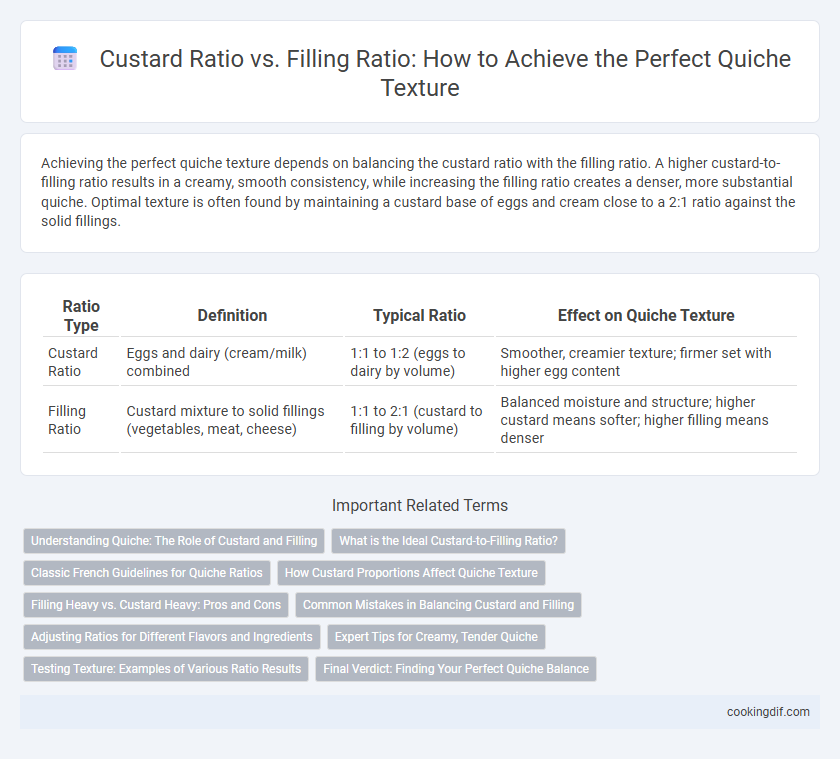Achieving the perfect quiche texture depends on balancing the custard ratio with the filling ratio. A higher custard-to-filling ratio results in a creamy, smooth consistency, while increasing the filling ratio creates a denser, more substantial quiche. Optimal texture is often found by maintaining a custard base of eggs and cream close to a 2:1 ratio against the solid fillings.
Table of Comparison
| Ratio Type | Definition | Typical Ratio | Effect on Quiche Texture |
|---|---|---|---|
| Custard Ratio | Eggs and dairy (cream/milk) combined | 1:1 to 1:2 (eggs to dairy by volume) | Smoother, creamier texture; firmer set with higher egg content |
| Filling Ratio | Custard mixture to solid fillings (vegetables, meat, cheese) | 1:1 to 2:1 (custard to filling by volume) | Balanced moisture and structure; higher custard means softer; higher filling means denser |
Understanding Quiche: The Role of Custard and Filling
The ideal quiche texture balances a custard ratio of eggs and dairy with a generous filling ratio of vegetables, cheese, or meat to create a creamy yet structured consistency. A custard ratio typically involves three large eggs per cup of dairy, ensuring a smooth base that sets properly without becoming rubbery. Adjusting the filling ratio influences moisture and flavor, requiring careful balance to prevent a soggy crust while maintaining a rich, savory bite.
What is the Ideal Custard-to-Filling Ratio?
The ideal custard-to-filling ratio for a quiche typically ranges from 1:1 to 1:2, balancing the rich, creamy custard with the density of the fillings like vegetables, cheese, and meats. A higher custard ratio creates a silkier, more delicate texture, while a heavier filling ratio yields a thicker, more substantial slice with a heartier bite. Maintaining this balance ensures the quiche sets properly without becoming either too runny or overly dry.
Classic French Guidelines for Quiche Ratios
The classic French guideline for quiche texture emphasizes a balanced custard ratio of 1 part eggs to 1 part dairy, typically cream or milk, ensuring a smooth, silky filling. The filling ratio usually prioritizes about 60% custard to 40% solid ingredients like cheese, vegetables, or meats, maintaining a tender, yet structured quiche. Adhering to these proportions produces the ideal creamy texture while preserving the integrity of the flavorful fillings.
How Custard Proportions Affect Quiche Texture
The custard ratio, typically a blend of eggs and cream or milk, directly influences quiche texture by determining its firmness and creaminess; a higher egg-to-dairy ratio yields a denser, more custard-like consistency while more dairy creates a lighter, silkier filling. Maintaining an optimal filling ratio that balances custard with solid ingredients like cheese, vegetables, or meats ensures even baking and prevents sogginess. Precise control of these proportions results in a quiche that holds its shape yet remains tender and smooth.
Filling Heavy vs. Custard Heavy: Pros and Cons
A filling-heavy quiche emphasizes solid ingredients like vegetables, meats, and cheeses, resulting in a denser texture and more pronounced flavors, but it can make the quiche firmer and less custard-like. A custard-heavy quiche contains a higher egg and cream ratio, yielding a smoother, creamier texture with a delicate mouthfeel, although it may be less flavorful and structurally more fragile. Balancing the custard-to-filling ratio is crucial for achieving desired texture--typically a 1:1 ratio offers a harmonious blend, while shifting toward more filling or custard alters firmness and richness significantly.
Common Mistakes in Balancing Custard and Filling
Common mistakes in balancing custard and filling ratios for quiche often lead to either a soggy crust or a rubbery texture. Using too much custard compared to filling results in a wet, under-set quiche, while excessive filling with insufficient custard creates a dry and crumbly interior. Achieving the ideal ratio of approximately 2 parts custard to 3 parts filling ensures a smooth, creamy texture with balanced firmness.
Adjusting Ratios for Different Flavors and Ingredients
Adjusting the custard-to-filling ratio in quiche recipes is essential for achieving the desired texture based on specific flavors and ingredients. Higher custard ratios create a creamier, silkier quiche ideal for delicate ingredients like spinach or mushrooms, while denser fillings such as sausage or roasted vegetables benefit from a lower custard proportion to maintain structure. Balancing egg and cream percentages allows precise control over moisture and firmness, optimizing the final bite according to the chosen flavors.
Expert Tips for Creamy, Tender Quiche
For a creamy, tender quiche, maintain a custard ratio of roughly 1 egg to 1/2 cup of dairy, typically heavy cream or whole milk, which ensures proper setting without toughness. The filling ratio should balance meat, cheese, and vegetables with the custard to avoid sogginess, aiming for about 50% filling to 50% custard by volume. Using this expert ratio control delivers a smooth texture and harmonious flavor in every slice.
Testing Texture: Examples of Various Ratio Results
Testing texture in quiche involves adjusting the custard-to-filling ratio, which significantly impacts the final mouthfeel. A higher custard ratio, such as 2:1 (custard to filling), produces a creamy, smooth texture, while a balanced 1:1 ratio offers a firmer consistency with distinct filling chunks. Ratios with more filling, for example 1:2, result in a denser, more substantial bite but can lead to a less cohesive custard structure.
Final Verdict: Finding Your Perfect Quiche Balance
Achieving the ideal quiche texture relies on balancing the custard ratio, typically eggs to cream, with the filling ratio of vegetables, cheese, and meats. A custard ratio of about 1 large egg to 1/2 cup of cream creates a smooth, creamy base that sets well without becoming rubbery, while maintaining a filling ratio where solids comprise roughly 50-60% ensures a harmonious bite. Experimenting within these ranges allows home cooks to perfect their quiche's texture, achieving a custard that is neither too runny nor overly dense, complemented by fillings that enhance flavor without overwhelming the custard's delicate consistency.
custard ratio vs filling ratio for quiche texture Infographic

 cookingdif.com
cookingdif.com